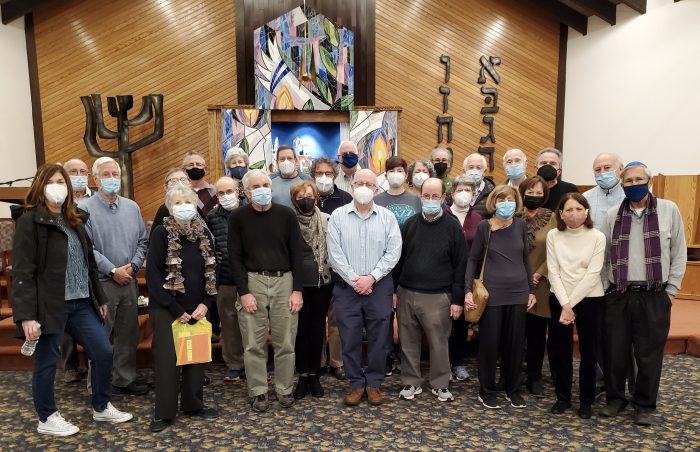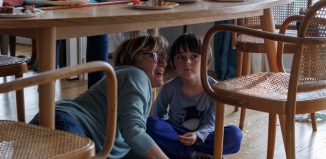A face-to-face event cheers Temple Isaiah of Stony Brook members on a rainy day

By Donna Newman
On Dec. 18 about 30 congregants attended an in-person event at Temple Isaiah of Stony Brook to learn about and celebrate the synagogue’s 56-year history. It was the first such event planned since the COVID-19 pandemic began. Small groups of fully vaccinated, masked and socially distanced participants rotated through four talks around the building.
“In suggesting and coordinating this program, I had several objectives in mind,” Rabbi Paul Sidlofsky said. “Giving the opportunity for members to gather safely in our building; creating an alternate Shabbat day experience that would attract members; and highlighting the rich history and tremendous resources, both human and facility, of Temple Isaiah.”
He added he is grateful the event was a resounding success and appreciates all those who came to lead and participate.
Founding members Barbara and Jerry Fine presented the temple’s origin story, which began in early 1965 when a small notice appeared in the Three Village Herald. Eli Kahn, said Fine, was the prime mover of the plan to establish a Reform Jewish congregation. He was seeking like-minded people.
“Several members of the [existing] Conservative Jewish Center were looking for a more liberal synagogue,” said Fine. His wife, Barbara, shared her view that it was definitely needed. Having grown up in an Orthodox Jewish home, she wanted to be part of a religious group that viewed females as equals, she said.
Rabbi Emeritus Stephen Karol, who displayed a photo of the sanctuary as it appeared when he joined the temple in 2006, spoke of the changes made over the years and his emotional connection to the space.
“This room is filled with objects created by members of the congregation and that adds to the soul of this sanctuary,” he said. “Only the ner tamid [eternal light] suspended before the ark [the cabinet that holds Torah scrolls] and the menorah appear in this old photo.”
The menorah, crafted by artist Joe Donnelly, has become a symbol of Temple Isaiah. The ner tamid was created by Ludwig Yehuda Wolpert, a world-renowned, German-born, Israeli metalwork designer.
Congregant gifts include a tapestry by artist Lydie Egosi; two additional pieces of wall-mounted art created by Donnelly –Holocaust Memorial and a depiction of the Ten Commandments; a marble-topped candle-lighting table built by Steve Hiller; a Torah stand constructed as an Eagle Scout project by Shawn Countess; handmade Torah covers by Deborah Fisher; and Torah binders quilted by Joan Korins.
Attendees visited the Adam D. Fisher Library, named for Temple Isaiah’s longest serving, and now, rabbi emeritus – an appropriate honor for an author of liturgy, educational books, poetry and fiction.
“We built it as a gift for him, and he gifted it right back to the congregation,” said member Carole-Anne Gordon. In retirement, Fisher has overseen and curated the library – and even built furniture for it.
“This is one of the most extensive collections of Judaica existing in a synagogue library,” said Fisher proudly, as he listed the multitude of items available.
A fourth presentation was given by long-time temple member Steve Weitzman, who told the group about the supervising organizations that oversee and assist Reform Jewish congregations, how they have changed over the years and how liturgy has evolved.
For the most part, Temple Isaiah has held services and B’nai Mitzvah virtually via Zoom or livestreaming since pandemic restrictions eased after the initial lockdown. Dec. 18 provided an afternoon of smiles for those who attended. If only life could return to a semblance of normalcy.






